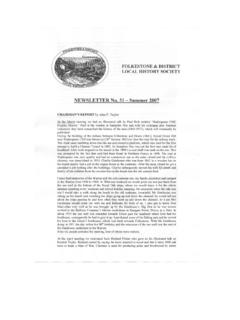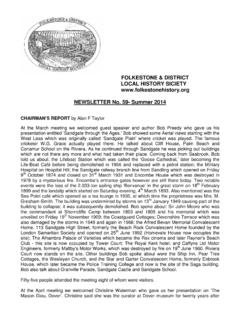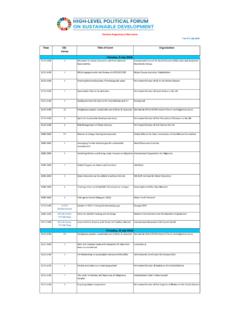Transcription of FOLKESTONE & DISTRICT LOCAL HISTORY …
1 FOLKESTONE & DISTRICT LOCAL HISTORY society NEWSLETTER No. 52 Autumn 2012 CHAIRMAN S REPORT by Alan F Taylor The society had a gazebo on the Leas for the Air Show on Saturday 2nd June. We set up a photograph display in which I had about seventy five photographs of street views and shop fronts in Sandgate Road, Vince Williams had similar on Cheriton. We also set up our bookstall which along with the photographs proved very popular. At the June meeting we welcomed guest speaker Dr Andrew Richardson who gave us a power-point presentation on FOLKESTONE A Town Unearthed.
2 Andrew started by telling us that Dr Lesley Hardy and himself were two years planning and getting funding for the Roman Villa dig on East Cliff. He said they also had a programme digging in peoples back gardens. A big focus was on East Wear Bay partly because of the things found on the beach. He went on to say Museum staff had been digging on the East Cliff in 1919 and 1920 and made some finds. In 1923 Mr S E Winbolt, a visitor to FOLKESTONE , found a Roman drain and several walls exposed by a recent fall of cliff. The FOLKESTONE Town Council thought this could be a major tourist attraction so they commissioned S E Winbolt to do a dig.
3 Preliminary excavations by him in April, 1924 and large scale work in August cleared most of the site the work being carried out by a team of unemployed men and volunteers. In just eight weeks this revealed a major Roman villa, one of the largest known in Kent. The Corporation of FOLKESTONE provided a wooden cover-building over the Roman mosaic and the site was open to the public for many years. It was closed during WWII and the cover-building damaged and removed. The site was filled in with ash from the East Cliff Corporation Works in about 1957and forgotten. In 1989 a programme of work was carried out by Kent Archaeological Rescue Unit for Shepway DISTRICT Council to ascertain how much of block C , (the bath house) had gone over the cliff.
4 Before the main dig started in 2010 they dug some trenches north of the villa site and found Iron Age archaeology, one of the finds was a late Iron Age Gallo-Belgic gold coin. The main dig concentrated on the north east corner of block A the villa s court-yard. A fourth century surface dating back to 350AD was uncovered, under which was found another earlier court-yard from about 200AD. Andrew finished his talk telling us about some of the finds which included a brooch in the shape of a hare, a signet gem stone, wine jars possibly linked to importing wine, quern stones used for grinding corn and lots of pottery and tiles.
5 Fifty-seven people attended the meeting one of whom was a visitor. At the July meeting, one of our members, Hilary Tolputt gave a talk entitled A Journey in time down Coolinge Lane . Hilary described her enjoyment as a teenager in the variety of properties, the farm, the riding school and stables, the fields and the fine school buildings with their extensive grounds which had awakened her interest in the HISTORY of Coolinge Lane. She began her illustrated talk by displaying a map of Coolinge Lane in the middle of the nineteenth century, showing a narrow, rural track with a Martello Tower on the escarpment and the buildings and fields of Coolinge farm.
6 Pictures were shown of Coolinge farmhouse mostly built at the end of the eighteenth and beginning of the nineteenth century, and the next door property, the eighteenth century Coolinge House, a listed building like Coolinge farmhouse, which was originally three cottages. By the beginning of the twentieth century, the Heritage family farmed Coolinge farm and the Kennetts were running a dairy at Coolinge House for the Metropole Hotel. After the coming of the railway, the Shorncliffe Inn (now the Nailbox pub), the station master s house (now called the Wilderness) and a terrace of Victorian houses were built at the Shorncliffe Road end of the lane.
7 At the Sandgate Hill end of Coolinge Lane, private schools, located in the west end of FOLKESTONE began to re-locate to Coolinge Lane. Hilary showed 1892 plans of Pelham House school (now known as St Stephens and on the site of the FOLKESTONE School for Girls) kindly loaned by Alan Taylor which appeared in the Builders News . This exclusive boys preparatory school had a commanding situation overlooking Sandgate. With the sale of the Catchpool Estate, other schools moved to Coolinge Lane, including Praetoria House school (now called Penfold House), Bayham House School (later called Clewer House), Eversley College, an exclusive girls school and Westbourne House School, originally a pre-preparatory school.
8 Pictures were shown of these schools before 1914. All of the schools were closed in the First World War and tents were pitched in one of the fields in Coolinge Lane and used as accommodation for soldiers before they left for the Western front. The later HISTORY of the school buildings was discussed. Pelham House School and Bayham House (renamed Clewer) became St Stephens College, a girls school run in the inter war years by the Clewer nuns, an Anglican order of nuns , while FOLKESTONE County school for Girls moved into Praetoria House renaming it Penfold House after their first Chairman.
9 Kent County Council acquired all the Coolinge Lane school buildings and grounds after the Second World War, and used these buildings in a variety of ways for educational purposes from 1946, including the education of girls, 2 school boarding houses, initial teacher training, and in-service teacher training. The sale of Westbourne House in 1985 led firstly to the building of Blenheim Place and very recently to the demolition of the House and building of Westbourne Heights. Eversley College, which from 1993 had been a Japanese Language School, had recently been bought by a property company.
10 Hilary explained how the character of the lane had been changed by the sale of Coolinge farm in 1961 showing pictures of the farm buildings in the 1950 s and the properties now on the site, namely Churchill and Spencer House. Furthermore, Sandgate Primary had been unable to accommodate all the pupils from the Golden Valley in their buildings on Sandgate Hill and a new school was built in 1972 on the tennis courts of the FOLKESTONE Girls Grammar School. Hilary concluded by showing an aerial picture of Coolinge Lane in 2010 and shots of the demolition of Clewer House and the houses being built on the site in 2012.






